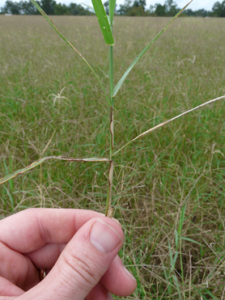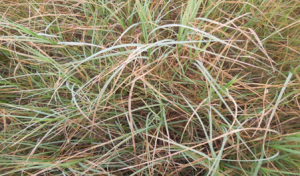

(Jeremy Kichler – Colquitt County Ag Report)
Leaf Rust (Puccinia) – At first glance, leaf rust may appear similar to leaf spot diseases in grasses, and sometimes use of a microscope is needed to identify one or the other. But at closer inspection, rust lesions will most often appear as orange or red pustules or raised areas on leaves and stems. Rubbing an infected leaf will leave rust-colored areas on your fingers or clothing.
Management and Control Strategies – Unlike other components of the previously mentioned “forage pest-trifecta” where chemical control options exist, there are no legal, effective, or economical fungicides to control any of the common forage disease issues you might encounter. This leaves management or “cultural practices” as the only tools in your toolbox. As also mentioned previously, disease pathogens are almost always present in the environment – it is most often a combination of adverse environmental conditions and stressed plants that is the main factor resulting in disease problems.
From a management perspective, there are five practices that are effective in reducing the risk of disease infection – 1) Selecting a resistant variety, 2) maintaining soil fertility, 3) managing irrigation, 4) removing thatch, and 5) harvesting forage in a timely manner.
1) Variety Selection – This is especially important in Bermuda and also bahiagrass varieties, as some varieties are more inherently resistant to some fungal diseases. Varieties such as Coastal, Tifton 44, and Tifton 85 were bred to be more resistant to leaf spot diseases than what has been observed in common bermudagrass or Alicia. In bahiagrass, Argentine has been shown as less susceptible to dollar spot than other varieties like Tifton-9 or TifQuik. If deciding to seed or plant new establishments, consult with your Extension agent or company representative to discuss disease tolerances.
2) Soil Fertility – This is probably one of the most important management principals to help prevent potential issues. Many disease issues, especially in warm season grasses, are tied to poor fertility –namely potassium deficiency. Timely soil sampling and good fertility management can help any variety of forage to be more stress tolerant and disease resistant. It may also be useful to collect tissue samples from diseased forages to determine if potassium is deficient in tissue if a soil analysis is not available.
3) Irrigation – Almost every forage disease issue is related to water – whether it be overly wet conditions from rainfall, or ponding due to poor soil drainage. Too much water and fungal diseases almost always go together. While it is difficult to manage water in a dryland situation, managing irrigation schedules to prevent plants being wet for several hours at a time is preferred. If running irrigation, many producers have had success by turning off irrigation from mid-afternoon until the following morning, so as to prevent having grass being wet going into evening and staying wet until the following day.
4) Thatch – In many situations, a buildup of thatch material can contribute to disease issues. The abundant organic matter and inhibition of airflow to dry out wet material helps create a suitable environment for fungal growth and disease outbreaks. Also, thick plant material can serve as a harbor for spores and future disease development. In some situations, burning of fields in the springtime to reduce thatch is recommended.
5) Timely Harvest – Related to the previous point, timely harvest can prevent a buildup of plant material that would allow for disease development. Also, leaf spot and other diseases are more prone in under-grazed or over-grown situations, so timely harvest will keep plants actively growing and could help keep older plant material from becoming infected.
In an ideal world, diseases are not a common forage production concern. But things are never ideal. In a good weather year, diseases may be minimal. But in a very wet year, disease may be much more common. In these situations, implementing the strategies mentioned can help prevent a potential problem from becoming a serious, even devastating problem.